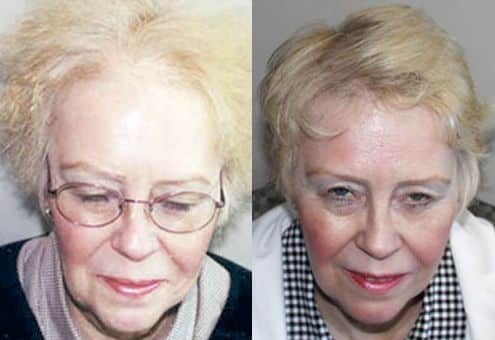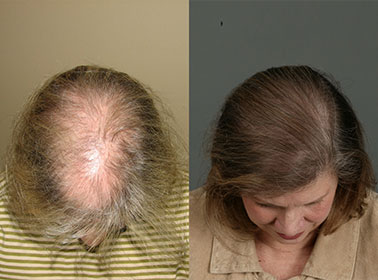
Ronald Shapiro MD, Cosmetic Beauty Magazine, Feb 2006, Pg 33
“It is not just for men any more”
“Follicular Unit” hair transplantation has revolutionized the field. If a patient chooses a physician who is skilled and experienced them can obtain hair transplants results that are so natural they are undetectable even under close examination. What many people don’t know is that women as well as men have benefited from this advancement. The following are some of the ways hair transplantation surgery can be used to help women.


“Female Pattern” Alopecia
It is not generally known that 1 in 4 women suffer from an entity called “Female Pattern” alopecia. This is a different entity and produces a different pattern then “Male Pattern” alopecia so well recognized in men. With “Female Pattern” alopecia the hairline is preserved but there are various degrees of diffuse thinning behind the hairline. It can start in patients 30’s and progress slowly over time. The severity is unpredictable and can range from barely noticeable to nearly bald. When the thinning is severe it can be socially devastating. In our society it is socially acceptable for a man to lose his hair. After all, a majority of men have some degree of noticeable hair loss by the time they reach midlife. Hair loss in females is not as socially acceptable because noticeable female hair loss is much less common. With female pattern baldness, women feel “abnormal” and find themselves in a position that makes them extraordinarily uncomfortable. They attempt to find hairstylists that will hide this embarrassing condition. Many move to wigs. If the problem is not addressed, they may remove themselves from family and public events. Many of these women can be helped with new hair transplantation techniques. Like men the procedure in women involves transferring hair from the donor region in the back of the head the thinning areas on the top of the head.
The goal is to bring back enough volume and appearance of fullness in a thinning areas that a patient can look normal and feel comfortable in most social situations.
Lowering High Frontal Hairlines
Some women are born with genetically higher hairlines commonly referred to as “Queen Ann” hairline. In other case the hairline may have been unintentionally artificially raised after a brow lift. Hair transplantation can be used to lower these high hairlines and give the appearance of a smaller forehead
Thickening Weak Temporal (Side) Hairlines
Some women develop thin side hairlines as they age or after face lift surgery. In other case the side hairline can become weak due to trauma from long term braiding or hair straightening. It makes it difficult for women to pull there hair back with this type of thinning. The smaller grafts used in follicular unit transplantation can be used to treat this area.
Eyebrow and Eye Lash Transplantation
Thin eye brows or eyebrows that have been lost due to trauma or disease are another type of hair loss that can be treated with hair transplantation. When treating eyebrows it is important to exactly mimic the angle and direction of the original eyebrow hair. Because the hair used to transplant eyebrows comes from the donor area in the back of the head and grows long, they have to be trimmed on a regular basis to keep them at the length of normal eyebrow hair.
Covering Post-Cosmetic Surgery Scars From Face And Brow Lifts
Face lifts and Brow lifts will occasionally leave a noticeable scar in the scalp. These scars can be covered up with hair transplantation
Repairing Hair Loss From Disease Or Trauma
Hair loss can occur from a number different diseases and/or traumas. Traction alopecia (constant braiding), trichotilimania (constant hair pulling), burns, overly permed hair, or post radiation treatment for cancer are just a few. These are other areas that hair transplantation has been used successfully.
One can see there are many situations in which hair transplantation can be used to treat various types of hair loss in women. Not all women are good candidates for these repairs but many are. It is important to seek the services of a physician skilled and experienced with treating hair loss in women. In addition to surgery the physician may suggest medical treatment with Rogaine and a variety of effective cover-ups.

